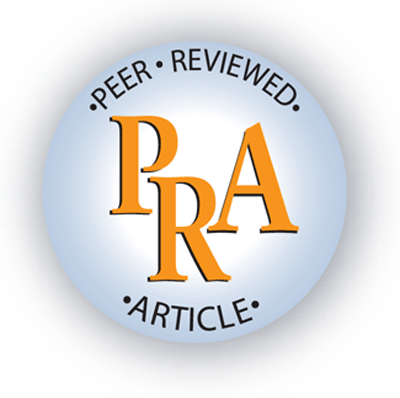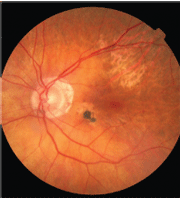
Over the last few decades, there has been much discussion about the systemic health benefits of drinking red wine in moderation (about one to two glasses a day). The French paradox has always perplexed us in the United Stateshow could a population with a diet so rich in heavy creams and meats outlive Americans by an average of 10 years?1,2 Researchers believe that the regular consumption of red wine allows the French to counterbalance their rather fatty diets and live healthier lives.3 But, could it also be possible that their incidence of cataracts and age-related macular degeneration (AMD) may be lower due to wine consumption?
While previous research has shown that drinking wine in moderation might enhance overall systemic wellness, let us examine the ocular health benefits of moderate wine consumption.
Resveratrol: Wines Champion
Overall, the consumption of grapes and grape skins is very beneficial for systemic health. Grapes contain polyphenolscompounds derived from plantsthat act as antioxidants. Polyphenols have been shown to protect humans from both heart disease and various forms of cancer.4
But, one polyphenol found in grape skins stands above the rest: resveratrol. Resveratrol is a phytoestrogen, which is a type of plant estrogen. It has been shown to fight inflammation, inhibit oxidation of certain cells, and prevent apoptosis, or cell death.5
Quite fortunately for those of us who enjoy a Burgundian Pinot Noir, red wine is one of the bestand most readily availablesources of resveratrol. Because the grape skins used to make red wine are in contact with each other longer than the grape skins used to make white wine, red wine has a higher concentration of resveratrol.3,6

Drinking red wine in moderation provides several ocular health benefits. Here, author Paul Karpecki, O.D., takes a moment to reduce his chances of developing cataracts.
Resveratrol is also present in berries, nuts and grape juice. However, ounce-for-ounce, red wine also contains two times more flavonoids and other antioxidants than any of the aforementioned sources.6 Additionally, the particular fermentation process used to make wine allows resveratrol to be absorbed by the body more easily.7
Wine and Cataracts
The authors of the five-year Reykjavik Eye Study had little difficulty gathering 1,045 subjects to examine the ocular effects of moderate wine consumption.8 Each participants crystalline lens was examined using photographed images. Patients with opacities of grade 1 and higher or pseudophakia/aphakia at five years of study were listed as having cataracts.
Each subjects level of alcohol consumption was determined by a simple questionnaire. The four determined categories were: lifetime abstainers, former drinkers, consumers of less than one drink per month and consumers of more than two drinks per month. For the purposes of this study, only those who noted consuming more than two drinks a month were considered drinkers.

Evidence suggests that regularly drinking wine in conjunction with a diet rich in antioxidants may protect against AMD, as seen in this patient.
A statistical analysis was performed using logistic regression while controlling for age, sex, smoking habits, systemic steroid use and diabetes. The age-adjusted, five-year incidence of any type of cataract was 32.2% among non-drinkers; however, only 13% of individuals who moderately consumed wine developed cataracts.8 A decreased risk for any type of cataract was specifically found in red wine drinkers. In particular, red wine drinkers were found to have a decreased risk for both cortical and nuclear cataract formation; however, no measurable association was noted for posterior subcapsular cataract development.8
The actual relationship between moderate wine consumption and a lower risk of cataract formation is still not entirely understood. New research suggests that the association is related to ingestion of certain antioxidants found in red wine.9
But, how does the consumption of red wine and resveratrol prevent cataracts? This was the subject of an experimental study involving rats.10 Previous studies have shown that a subcutaneous injection of selenite can induce senile cataract development.10 So, in this study, the rats were either injected with saline, sodium selenite or sodium selenite with 40mg/kg of resveratrol. Cataract development was graded using photography 11 days after the injections. The lenses were then analyzed for lipid peroxidation, an indication of cataract development.
The results showed that all the control crystalline lenses (rats that received the plain saline injection) were entirely devoid of cataracts, while the lenses from group two (rats that received the selenite injection) had a 100% incidence of cataract development. In this group, cataract development was graded between three and six in each eye, with a score of six denoting the highest level of incidence. In group three (rats that received both selenite and resveratrol), seven of the 16 subjects showed no cataract development, and the cataracts of the other nine were all grade 3 or less, a statistically significant difference from group two.
The researchers concluded that the resveratrol suppressed selenite-induced oxidative stress and cataract formation in rats, which strengthens the hypothesis that increased consumption of red wine may help prevent human senile cataract formation.10
Wine and AMD
Epidemiological evidence suggests that regularly drinking wine in conjunction with an antioxidant-rich diet may protect against age-related macular degeneration, the leading cause of vision loss among the elderly.
One study, published in the Journal of the American Geriatrics Society, showed a direct association between moderate red wine consumption and decreased risk for AMD development.11 The study included 3,072 adults between the ages of 45 and 74, all of whom demonstrated macular changes indicative of AMD. The investigators determined all AMD diagnoses through funduscopic examination.
They observed a strong negative association between AMD incidence and the ingestion of wine.11 Beer and hard liquor consumption showed no significant effect on reducing the risk for macular degeneration; however, when combined with wine, a measurable negative association was found. Nonetheless, the investigators say that it would be premature to make any recommendations based on this single study.11
Other research about the components of red grapesnamely, red grape skinsshows a very high concentration of the carotenoids lutein and zeaxanthin, which may help in combating AMD.12
Additional studies have suggested that resveratrol may play a key role in reducing the likelihood of AMD. The autofluorescent pigments that accumulate in retinal pigment epithelial (RPE) cells with aging have been implicated in the etiology of macular degeneration. The major culprit is the fluorophore A2E. When exposed to sunlight, the A2E-laden RPE exhibits a propensity for apoptosis.13
The Dangers of Overdrinking While moderate consumption of red wine has been shown to provide both systemic and ocular benefits, over-consumption of alcohol, in general, is detrimental to your health. Overdrinking can lead to liver damage and heart disease, and may even increase the chances for certain forms of cancer.
Mass spectrometry has revealed that vitamins E and C, butylated hydroxytoluene, resveratrol and bilberry extract reduce A2E damage. Furthermore, electrophoresis and cell viability studies revealed a corresponding reduction in the incidence of DNA damage and associated cell death.13
Liver disease. Studies have long shown that alcohol has negative effects on the liver and other related tissues.26 Animal studies in the 1960s and 1970s showed a direct link between cirrhosis of the liver and alcohol consumption.27 Recent research has found that the main mechanism in liver cirrhosis is triggered by activation of hepatic stellate cells, which acquire a myofibroblast-like phenotype.28 It is interesting to note that phenolic compounds contained in red wine have been shown to have antifibrotic effects on activated hepatic stellate cells.28
Heart disease. Chronic, excessive alcohol intake could cause several heart disease conditions. Research has shown that drinking alcohol in excess is directly associated with coronary occlusion, arrhythmias and fetal alcohol syndrome.29
To emphasize this point, additional research has shown that mortality rates in patients with ischemic heart disease (IHD) are statistically higher if the individuals are heavy drinkers.30
Cancer incidence. Epidemiological data has identified chronic, excessive alcohol consumption as a risk factor for certain cancers, including those of the respiratory tract, upper gastrointestinal, liver, breast and colon.31 Alcohol consumption generates acetaldehyde acetone (AA) and causes free-radical damage.32 AA is the first and most relevant metabolite of ethanol, and is it the most carcinogenic and mutagenic agent in alcohol-associated cancer.33 Another contributing factor could be a nutritional deficiency, such a lack of folic or retinoic acid intake.
A study published at
Resveratrol was found to inhibit intracellular oxidation and protect the RPE cells from cell death. The observed reduction in cell proliferation was associated with inhibition of protein kinase (cells under stress release protein kinase, which results in a cascade that leads to cell death). Protein kinase was inhibited with resveratrol concentrations as low as 5micromol/L. These results suggest that increased resveratrol intake can reduce oxidative stress and hyperproliferation of the RPE cells of the retina.
Wet AMD and Anti-VEGF
New research also suggests that resveratrol may serve as a future treatment option for the management and/or prevention of exudative (wet) AMD and tumor formation. (Just imagine prescribing two to four glasses of Rosso di Montalcino per week!) Studies have shown that resveratrol has the ability to suppress angiogenesis.15 In one paper, researchers have found that a combination of grape seed proanthocyanidin (the tannins found in red wine) and resveratrol limits inducible secular vascular endothelial growth factor (VEGF) expression, a key element in preventing angiogenesis.16 Anti-VEGF therapy is the basis for all the current wet AMD treatments, such as Avastin (bevacizumab, Genentech) or Lucentis (ranibizumab, Genentech).
Corneal Benefits
While it makes sense that wine helps prevent vascularization of the retina and choroids, moderate wine consumption could also be beneficial for the cornea. One study has shown that resveratrol has the ability to suppress the enzyme matrix metalloproteinase-2 (MMP-2), which has been shown to play a role in causing recurrent corneal erosion and persistent epithelial defects.4 This study also demonstrated that resveratrol is able to actually reduce corneal neovascularization that was induced by proangiogenic factors in mouse eyes.4
Prevention of Cancers
Compelling research indicates that moderate wine consumption has favorable effects on the neurological, hepatic and cardiovascular systems. And, in the most recent investigations, red wine has proven to be a cancer chemopreventative agent. There is also evidence that red wine consumption decreases the risk of basal cell carcinoma and non-Hodgkin lymphoma, in addition to reducing the risk for developing cancer of the upper digestive tract, lungs and colon.17
Studies have demonstrated that resveratrol blocks the multi-step process of carcinogenesis at various stages, including tumor initiation, promotion and progression.18 Some researchers believe resveratrol downregulates the inflammatory response through prevention of synthesis and release of pro-inflammatory mediators.5 Additionally, resveratrol inhibits activated immune cells or nitric oxide synthase, prostaglandin production and cyclooxygenase-2 (COX-2) inhibition.5
The Fountain of Youth?
Now, we have discussed some of the ocular and systemic health benefits of moderate red wine consumption. But, can drinking wine actually extend your life and keep you feeling younger? Some studies suggest that it will. Resveratrol may serve as an anti-aging agent because of its ability to prevent inflammation.19 Another study advocates that grape skins and seeds, used to produce the tannins found in wine, are equally effective in reducing myocardial ischemic reperfusion injury, and therefore, they play a crucial role in cardioprotection.20
An additional study found that resveratrol possesses pro-inflammatory properties and prevents the formation of blood clots in mice.21 Mice who consumed large quantities of the resveratrol compound lived about 33% longer than the mice that did not receive the supplement.21 Finally, grapes have also been found to contain quercetin, a powerful flavonoid and antioxidant that has been shown to prevent low-density lipoprotein (LDL), or bad cholesterol, from accumulating in the artery walls.22
A Note On Alcohol Consumption
As health-care providers, it is imperative that we supply education to our patients on all aspects of wellness. Considering how simple it is to access health and medical data on the Web, it is not uncommon for patients to seek information on such topics as the ocular benefits of red wine consumption.
If your patients do read something about this, they will likely approach you for details on the exact benefits and risks of drinking wine. You must be prepared to educate your patients not only of the ocular benefits of drinking red wine, but also the negative health risks associated with excessive alcohol consumption. Alcohol consumption should be part of a thorough patient history. The volume of alcohol a patient consumes is very important. The difference between moderate and excessive alcohol consumption may be the difference between preventing and actually causing disease.23
You should also ask what type of alcohol your patients are consuming. For example, drinking one to two glasses of red wine per day yields health benefits that are not obtained by moderately consuming whiskey or beer.8,24
One study of both clinical and experimental trials showed that red wine does, indeed, offer more systemic health benefits than other alcoholic beverages.25 These benefits are attributed to grape-derived antioxidant polyphenolic compounds not found in other alcoholic beverages.
While the systemic perks of moderate red wine consumption have been touted for several years, a review of wines ocular health benefits has not been conducted until now. This research demonstrates that the natural compounds found in red wine will help protect your eyes from cataracts, age-related macular degeneration and other damaging conditions. So, round up your friends, uncork a
Dr. Karpecki practices at the Cincinnati Eye Institute in cornea services and ocular surface disease research. He is the education advisor for Review of Optometry and is co-author of Research Review. He is also a certified sommelier through the Court of Master Sommeliers.
1. Kopp P. Resveratrol, a phytoestrogen found in red wine. A possible explanation for the conundrum of the French paradox? Eur J Endocrinol 1998 Jun;138(6):619-20.
2. Providencia R. Cardiovascular protection from alcoholic drinks: scientific basis of the French Paradox. Rev Port Cardiol 2006 Nov;25(11):1043-58.
3. Opie LH, Lecour S. The red wine hypothesis: from concepts to protective signaling molecules. Eur Heart J 2007 Jul;28(14):1683-93.
4. Oak MH, Bedoui J, Schini-Kerth VB. Antiangiogenic properties of natural polyphenols from red wine and green tea. J Nutr Biochem 2005 Jan;16(1):1-8.
5. Shankar S, Singh G, Srivastava RK. Chemoprevention by resveratrol: molecular mechanisms and therapeutic potential. Front Biosci 2007 Sep 1;12:4839-54.
6. Dani C, Oliboni LS, Vanderlinde R, et al. Phenolic content and antioxidant activities of white and purple juices manufactured with organically- or conventionally-produced grapes. Food Chem Toxicol 2007 Dec;45(12):2574-80.
7. Becker JV, Armstrong GO, van der Merwe MJ, et al. Metabolic engineering of Saccharomyces cerevisiae for the synthesis of the wine-related antioxidant resveratrol. FEMS Yeast Res 2003 Oct;4(1):79-85.
8. Sasaki H, Jonasson F, Suwa Y, et al. The protective effect of wine intake on five years incidence of cataract
9. Ariga T. The antioxidative function, preventive action on disease and utilization of proanthocyanidins. Biofactors 2004;21(1-4):197-201.
10. Doganay S, Borazan M, Iraz M, et al. The effect of resveratrol in experimental cataract model formed by sodium selenite. Curr Eye Res 2006 Feb;31(2):147-53.
11. Obisesan TO, Hirsch R, Kosoko O, et al. Moderate wine consumption is associated with decreased odds of developing age-related macular degeneration in NHANES-1. J Am Geriatr Soc 1998 Jan;46(1):1-7.
12. Mendes-Pinto MM, Ferreira AC, Oliveira MB, et al. Evaluation of some carotenoids in grapes by reversed and normal-phase liquid chromatography: a qualitative analysis. J Agric Food Chem 2004 May 19;52(10):3182-8.
13. Sparrow JR, Vollmer-Snarr HR, Zhou J, et al. A2E-epoxides damage DNA in retinal pigment epithelial cells. Vitamin E and other antioxidants inhibit A2E-epoxide formation. J Biol Chem 2003 May 16;278(20):18207-13.
14. King RE,
15. Brkenhielm E, Cao R, Cao Y. Suppression of angiogenesis, tumor growth, and wound healing by resveratrol, a natural compound in red wine and grapes. FASEB J 2001 Aug;15(10):1798-800.
16. Sen CK, Khanna S, Gordillo G, et al. Oxygen, oxidants, and antioxidants in wound healing: an emerging paradigm. Ann NY Acad Sci 2002 May;957:239-49.
17. Bianchini F, Vainio H. Wine and resveratrol: mechanism of cancer prevention? Eur J Cancer Prev 2003 Oct;12(5):417-25.
18. Aggarwal BB, Bhardwaj A, Aggarwal RS, et al. Role of resveratrol in prevention and therapy of cancer: preclinical and clinical studies. Anticancer Res 2004 Sep-Oct;24(5A):
2783-840.
19. De la Lastra CA, Villegas I. Resveratrol as an anti-inflammatory and anti-aging agent: mechanisms and clinical implications. Mol Nutr Food Res 2005 May;49(5):405-30.
20. Das DK, Sato M, Ray PS, et al. Cardioprotection of red wine: role of polyphenolic antioxidants. Drugs Exp Clin Res 1999;25(2-3):115-20.
21. Baur JA, Pearson KJ, Price NL, et al. Resveratrol improves health and survival of mice on a high-calorie diet. Nature 2006 Nov 16;444(7117):337-42.
22. De Gaetano G, Cerletti C. Wine and cardiovascular disease. Nutr Metab Cardiovasc Dis 2001 Aug;11(4 Suppl):47-50.
23. Gaziano JM, Manson JE. Diet and heart disease. The role of fat, alcohol, and antioxidants. Cardiol Clin 1996 Feb;14(1):69-83.
24. Burns J, Crozier A, Lean ME. Alcohol consumption and mortality: is wine different from other alcoholic beverages? Nutr Metab Cardiovasc Dis 2001 Aug;11(4):249-58.
25. Aviram M, Fuhrman B. Wine flavonoids protect against LDL oxidation and atherosclerosis. Ann NY Acad Sci 2002 May;957:146-61.
26. Tremolieres J, Lowy R, Griffaton G. Metabolic effects of ethanol. Proc Nutr Soc 1972 Sep;31(2):107-15.
27. Lieber CS. Alcohol, nutrition, and the liver. Am J Clin Nutr 1973 Nov;26(11):1163-5.
28. Svegliati-Baroni G, Jezequel AM, Orlandi F. Wine: risk factors for liver disease and antibiotic compounds. Drugs Exp Clin Res 1999;25(2-3):143-5.
30. Kerr WC, Ye Y. Population-level relationships between alcohol consumption measures and Ischemic Heart Disease mortality in
31. Seitz HK, Becker P. Alcohol metabolism and cancer risk. Alcohol Res Health 2007;30(1):38-41,44-7.
32. Seitz HK, Maurer B, Stickel F. Alcohol consumption and cancer of the gastrointestinal tract. Dig Dis 2005;23(3-4):297:303.
33. Seitz HK, Meier P. The role of acetaldehyde in upper digestive tract cancer in alcoholics. Transl Res 2007 Jun;149(6):293-7.

